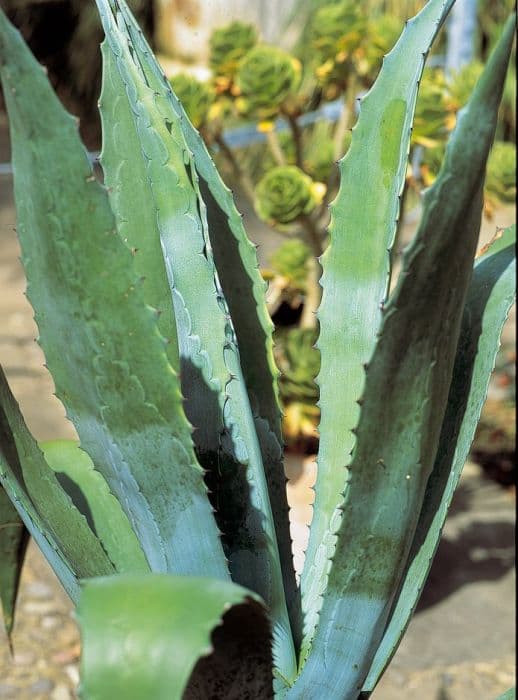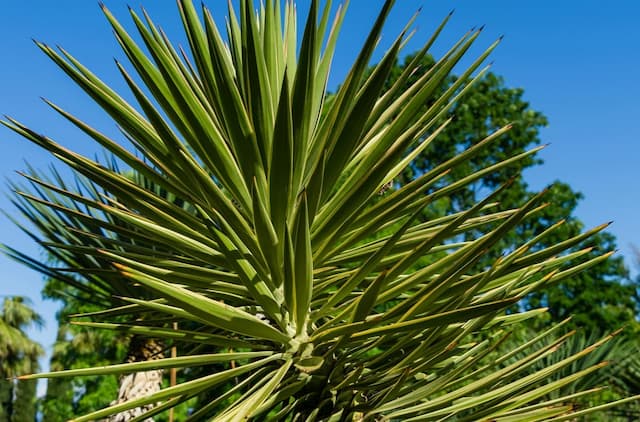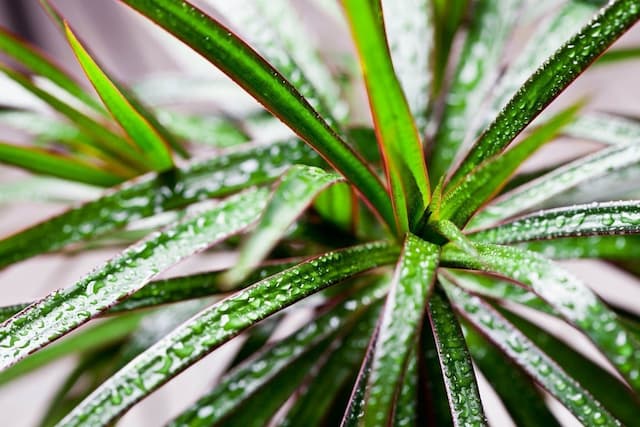Variegated yucca Yucca filamentosa 'Variegata' (v)

ABOUT
The Variegated Yucca features long, sword-like leaves that are truly striking in appearance. The leaves are edged with creamy white to pale yellow margins, creating a bold contrast against the green center. This variegation runs the length of the leaf, which ends in a soft thread-like fringe. This filament detail, from which it gets part of its name, adds a unique texture to the plant, making it visually interesting. The leaves emerge from a central rosette, radiating outwards in all directions, and can appear rigid and upright. During the blooming period, the Variegated Yucca produces tall flower spikes that bear bell-shaped flowers. These blooms can be white or off-white, adding an additional layer of visual appeal to the plant. Overall, the Variegated Yucca presents a robust and architectural look that can make it a focal point in any garden setting where it's used for ornamental purposes.
About this plant
 Names
NamesFamily
Asparagaceae
Synonyms
Variegated Adam's Needle, Variegated Yucca
Common names
Yucca filamentosa 'Variegata'.
 Toxicity
ToxicityTo humans
Adam's Needle is generally not considered highly toxic to humans. However, if any part of the plant is ingested, it can lead to mild symptoms. These symptoms might include nausea, vomiting, and diarrhea due to the saponin content. Handling the plant, particularly the pointed leaves, can also cause skin irritation in some individuals. Ingesting significant amounts could potentially lead to more severe reactions, although this is quite uncommon.
To pets
Adam's Needle can be toxic to pets, particularly dogs and cats. If a pet ingests parts of this plant, they may experience vomiting, diarrhea, and depression due to the saponins it contains. The pointed leaves can also cause physical injuries to pets, such as punctures or scratches. If a pet consumes a large amount of the plant, it could lead to more severe problems, and veterinary attention should be sought.
 Characteristics
CharacteristicsLife cycle
Perennials
Foliage type
Evergreen
Color of leaves
Variegated
Flower color
White
Height
2-3 feet (0.6-0.9 meters)
Spread
2-3 feet (0.6-0.9 meters)
Plant type
Shrub
Hardiness zones
4-10
Native area
Southeastern United States
Benefits
 General Benefits
General Benefits- Low Maintenance: The plant is drought-tolerant and does not require frequent watering, making it ideal for low-maintenance landscapes.
- Landscape Design: Its striking variegated foliage adds architectural interest and contrast to garden designs.
- Durability: Yucca filamentosa 'Variegata' is known for being robust and can survive in a range of soil types, including poor soils.
- Cold Tolerance: It is cold-hardy, allowing it to thrive in regions with cold winters.
- Pest Resistance: The plant is generally resistant to pests and diseases, which minimizes the need for chemical treatments.
- Attracts Wildlife: The flowers of the plant attract pollinators such as bees and butterflies, supporting local ecosystems.
- Erosion Control: Yucca filamentosa 'Variegata' has a deep root system that can help to stabilize soil and prevent erosion.
 Medical Properties
Medical Properties- This plant is not used for medical purposes.
 Air-purifying Qualities
Air-purifying QualitiesThis plant is not specifically known for air purifying qualities.
 Other Uses
Other Uses- Photography Prop: The bold variegated leaves of Yucca filamentosa make for a striking background or subject in plant photography.
- Fishing: The tough, fibrous leaves can be used to make improvised fishing line in survival situations.
- Education: The plant is used in horticultural education to teach students about xerophytic adaptations of plants in dry environments.
- Art Supplies: The fibrous leaves can be processed to make a natural paper or canvas for artists who prefer to work with plant-based materials.
- Sewing Material: Strips of the leaves can be used as natural ties or thread for sewing tasks such as securing garden plants to supports.
- Screening: The plant's dense foliage is often used as a living screen or privacy barrier in gardens and landscapes.
- Handicrafts: The dried leaves and flower stalks can be incorporated into handmade baskets or decorative crafts.
- Water Conservation Landscaping: Utilized in xeriscaping for its ability to thrive with limited water and contribute to water conservation practices.
- Low-Maintenance Ground Cover: Its resilience and spreading habit make it suitable for use as a ground cover in low-maintenance landscaping.
- Erosion Control: The extensive root system of Yucca filamentosa helps stabilize slopes and prevent soil erosion.
Interesting Facts
 Feng Shui
Feng ShuiThe Variegated Yucca is not used in Feng Shui practice.
 Zodiac Sign Compitability
Zodiac Sign CompitabilityThe Variegated Yucca is not used in astrology practice.
 Plant Symbolism
Plant Symbolism- Resilience: The Yucca plant's ability to thrive in harsh environments symbolizes endurance and the capacity to cope with difficulties.
- Purity: Its white flowers can represent cleanliness and purity, often used in rituals or as a symbol of new beginnings.
- Protection: Historically, the Yucca's sharp leaves were used for protection in native cultures, representing a safeguard against negative forces.
 Water
WaterFor the Variegated Yucca, allow the soil to dry out completely before watering again, which typically means watering every 1-2 weeks during the growing season and less frequently during the winter months. When you do water, make sure to thoroughly soak the soil until water runs out of the bottom of the pot, using approximately 1 gallon for large outdoor plants. Adjust the amount based on the size of the plant and the pot; indoor or smaller plants may require as little as 8-16 ounces. Overwatering can lead to root rot, so ensure proper drainage and avoid letting the plant sit in standing water.
 Light
LightThe Variegated Yucca thrives best in full sun to partial shade. A spot where the plant can receive at least 6 hours of direct sunlight daily is ideal. However, it can tolerate some light shade, especially in the hottest parts of the day or in extremely hot climates.
 Temperature
TemperatureThe Variegated Yucca can withstand temperatures as low as 0°F and as high as 90°F or more. It's a hardy plant that can survive brief periods of colder temperatures and frost. Ideally, though, the Variegated Yucca prefers to be in environments where the temperature ranges between 60°F and 80°F.
 Pruning
PruningPrune the Variegated Yucca to remove dead or damaged leaves and spent flower stalks, which helps maintain the plant’s appearance and health. This is best done in the spring or early summer. Pruning can be done annually, or as needed to remove old foliage or control the size of the plant.
 Cleaning
CleaningAs needed
 Soil
SoilThe best soil mix for the Variegated Yucca is a well-draining, sandy soil with a pH between 5.5 and 7.5. Adding perlite or coarse sand improves drainage and prevents root rot. Organic matter like compost can also be mixed in to provide nutrients.
 Repotting
RepottingThe Variegated Yucca is a slow-growing plant and typically needs to be repotted every 2-3 years. Repotting is best done in the spring or early summer when the plant is actively growing.
 Humidity & Misting
Humidity & MistingVariegated Yucca thrives in average to dry humidity levels. It is well-suited to the typical humidity found in most homes and does not require any special humidity adjustments.
 Suitable locations
Suitable locationsIndoor
Place in bright, indirect light; water sparingly.
Outdoor
Full sun, well-draining soil, tolerant of drought.
Hardiness zone
4-11 USDA
 Life cycle
Life cycleVariegated Yucca begins its life as a seed, which when sown in well-drained soil and with adequate warmth, germinates to produce a small seedling. As it grows, the seedling develops into a rosette of arching, sword-like leaves that are edged with creamy white stripes. The mature plant may remain in this vegetative stage for several years, becoming a larger and denser rosette of variegated leaves. After a few years, typically when conditions are favorable (sufficient light, water, and nutrients), it sends up a tall flowering stalk in late spring to summer, bearing clusters of bell-shaped, creamy white flowers. Once pollinated, these flowers produce capsules containing numerous seeds, thus completing the reproductive phase. The parent plant may die after flowering and setting seed, a characteristic of some perennials known as monocarpic, though it often produces offsets or pups around the base before doing so, ensuring the continuation of new plants.
 Propogation
PropogationPropogation time
Early summer
Propogation: The most popular method for propagating the Variegated Yucca is through division, typically done in the spring just before the growing season begins. To propagate by division, the plant must be carefully dug up and the root ball divided into sections, each with a portion of the root system and one or more growth points or rosettes. These sections are then replanted in well-draining soil, making sure to keep the same depth as they were originally growing to ensure the best chance of survival. Water the new divisions thoroughly after planting to help establish roots but be cautious not to overwater as Yucca prefers drier conditions. It's essential to use a sharp knife or spade to make clean cuts during the division process, which helps promote quicker healing and root development.









